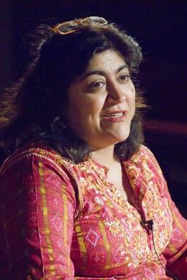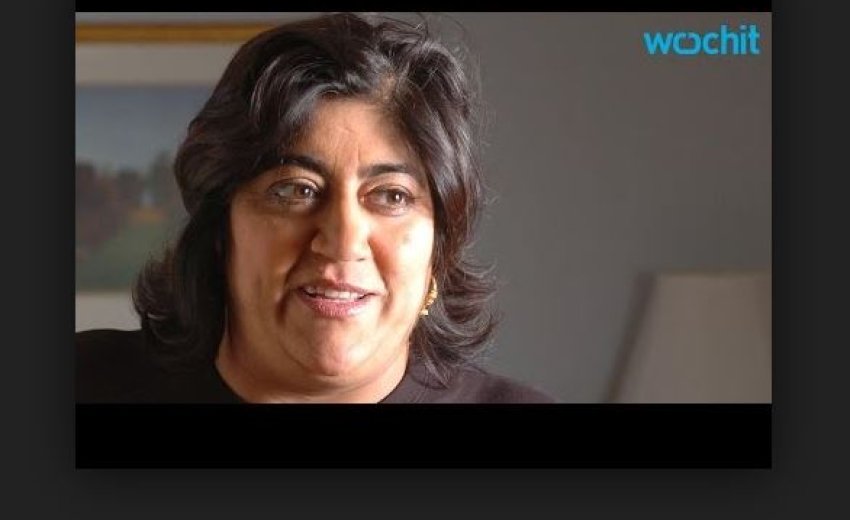 Monday, 21 July 2008 - The V&A continued its recent tradition of promoting Sikh heritage with the last in the series of Kapany lectures, Friday 18 July. The Lecture Theatre hosted Gurinder Chadha, director of Bend it Like Beckham and Bhaji on the Beach in conversation with Narinder Kapany about the rich and inspirational art and architecture of the Sikh heritage. They talk promised to focus on several of the most magnificent monuments and treasures that are currently threatened with destruction or decay.
Monday, 21 July 2008 - The V&A continued its recent tradition of promoting Sikh heritage with the last in the series of Kapany lectures, Friday 18 July. The Lecture Theatre hosted Gurinder Chadha, director of Bend it Like Beckham and Bhaji on the Beach in conversation with Narinder Kapany about the rich and inspirational art and architecture of the Sikh heritage. They talk promised to focus on several of the most magnificent monuments and treasures that are currently threatened with destruction or decay.
It was in the Punjab that the Islamic and Hindu arts combined to create one of the greatest cultural treasuries in the world, a treasury that found a unique expression in the arts and architecture of the Sikhs. A powerful combination of robust colour, strong narrative and brutal honesty distinguish Sikh art in all its forms prompting one 19th century observer to describe the unique colour palette of the Punjab as "warm and rich and fearless". The audience was given an insight into Sikh arts through an array of paintings and objects from both the Kapany collection and the V&A’s own collection that traces its origins to Maharaja Ranjit Singh’s toshakhana.
Dr Kapany explained that the Sikh architectural traditions uniquely fuse together the predominant forms and their evolution over four centuries mirrors the maturation of the faith. Gurinder Chadha quoted Khushwant Singh’s commentary on Sikh temple architecture in noting that “Its domes are different from domes of the mosques or Hindu temples, as are the arches, balconies, columns, interiors and general layout. It is therefore, very surprising that hitherto no serious study has been made in the Sikh style of architecture.â€
Today, that truly unique Sikh artistic heritage is under great threat. Few buildings, if any, remain from the sacred period of the Gurus and the Sikhs' own manuscript tradition is in tatters. Dr. Kapany noted that a toxic mix of ignorance, arrogance and official bureaucracy stand obstinately in the way of the progress that is desperately needed. He noted the excellent work being done by Gurmeet Rai and the CRCI in the restoration work at the Guru ki Maseet in Hargobindpur in Punjab. The issue of the destruction of Punjab’s built heritage was highlighted with an insight into the brutalisation of the Baba Atal Burj in Amritsar, the Versailles inspired palace of Kapurthala and the Qila Mubarack in Patiala. He also pointed to temple guardians literally whitewashing over depictions of the Gurus which were variant with the modern view of how they looked.
 Recalling the image of the Taliban demolishing the Bamiyan Buddhas in Afghanistan Gurinder Chadha reminded the audience that "The world's outrage at this atrocity was a clear reminder that we do in fact understand the price we collectively pay" no matter what our religion-when any cultural asset is lost or destroyed, for whatever reasons†and concluded the talk with the cautionary comment; "If this trend is allowed to continue, our important arts and monuments could be totally destroyed within as little as a generation" thus destroying the ability of our children, our grand children and the world at large to view the beauty and grandeur of our heritage. And we won't have the Taliban to blame. Only ourselves."
Recalling the image of the Taliban demolishing the Bamiyan Buddhas in Afghanistan Gurinder Chadha reminded the audience that "The world's outrage at this atrocity was a clear reminder that we do in fact understand the price we collectively pay" no matter what our religion-when any cultural asset is lost or destroyed, for whatever reasons†and concluded the talk with the cautionary comment; "If this trend is allowed to continue, our important arts and monuments could be totally destroyed within as little as a generation" thus destroying the ability of our children, our grand children and the world at large to view the beauty and grandeur of our heritage. And we won't have the Taliban to blame. Only ourselves."
These stirring concluding remarks made some of the their earlier omissions forgivable; the complete lack of Pahari or Sikh paintings in their discussions, the over reliance on some very average western paintings of Sikhs and the distinct lack of interpretation, precision or insight into the exposition into what constitutes Sikh material heritage. They also grossly minimised the problems of the situation in Punjab reducing the issue to pigeon droppings on buildings, UV light degradation and finger marks on weapons. The readers of this website will know that the situation is much more dire. For some reason the speakers did not want to mention the ritual cremation of Sikh manuscripts, the wilful pulling down of the built heritage and the utter vulgarisation of Sikh religious buildings in the name of kar seva – no more apparent that at the Harimandir Sahib.
The V&A has played host to a number of Sikh arts and heritage events over the years. These have been largely celebratory but it was most fitting that they were able to highlight the issues of conservation – giving it a much needed public profile. In that regard the conversation at the V&A will spark a constructive debate elsewhere.
Written by Amandeep Madra
(photographs by Jaspreet Kalsi)

